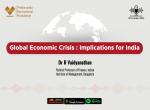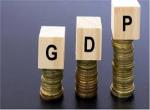"The men who can manage men manage the men who can manage only things, and the men who can manage money manage all." - Will Durant
China’s growing role and assertiveness in the international system is concurrent to its economic strength. However, its unprecedented rapid economic growth has put it in the unique situation where growth financed by investment and debt has reached their limits, marking the end of the upward phase of its long-term debt cycle in less than a quarter of a century. Yet the many ironies of our question are self-evident in the fact that a country saddled with debts more than 260 per cent of its Gross Domestic Product (GDP) is engaged with the world’s largest infrastructure lending program (aka the Belt and Road Initiative or BRI). Economists and Chinese policy makers widely agree and acknowledge that the health of the Chinese economy is at risk. However, opinions differ on how this risk will play out. Even then, the answer to whether China can handle its debt or not is not a simple yes-or-no answer, though much of that answer will be defining in curtailing or extending China’s power aspirations.
Background to Chinese Debt
Much of the Chinese debt came about to be after the 2008 crisis, from where on, China's debt as a percentage of gross domestic product grew more than 10 per cent a year on average. International Monetary Fund (IMF) estimates the ratio had ballooned to 260 per cent of GDP by 2016. Using the ‘Rule of 70’ in economics, that means the debt literally doubled in 7 years from 2008 to 2015. The State Council of China had announced a RMB 4 trillion (US$586 billion) stimulus package on November 9, 2008. Much of this stimulus led to a frenzy of fruitless infrastructure spending and consequent domestic debt, particularly among local governments and state-owned enterprises (SOEs) in a bid to shield the Chinese Economy from the global downturn.
Meanwhile, China made massive strides. It overtook Japan as world’s second largest economy in dollar value in 2010, became the world’s largest trader in 2013 and overtook the US as world largest economy by purchasing power parity (PPP) in 2014. Mismanagement in Chinese financial system started becoming evident when its largest bank (actually world’s largest bank), Industrial and Commercial Bank of China (ICBC) narrowly escaped a trust default with a last minute $500 million rescue.
In an era of Basel Accords (voluntary international banking regulations in regards to capital risk, market risk and operational risk), the apparent disconnect between Chinese banks’ relatively low level of Non-Performing Loans or NPLs (1.7 per cent) and the large stock of debt owed by corporations with low prospects of repayment, raises questions. Chinese financial system has developed rapidly in size and complexity and emerged as one of the world’s largest with financial assets at nearly 470 percent of GDP. Non-bank financial institutions (NBFI), including asset management and insurance companies have grown even faster than the banking sector. Banks seeking to satisfy savers’ search for yield while deposit interest rates were still controlled, developed strategies for moving assets out of their loan books (in form of trust loans, wealth management products (WMPs), etc.) while retaining some risks, to create capital headroom for new lending. Thus, even though credit to infrastructure, construction, and real estate sectors declined as a share of total bank credit, this seems to have been compensated by lending through other channels. This process has extended the life of the old growth model, contributing to a decline in productivity growth, and the build-up of corporate debt and risks1.
Deleveraging
Deleveraging or reducing the relative percentage of one’s balance sheet funded by liabilities is already underway in China. China has largely four options - debt restructuring, currency devaluation, economic growth and outright default. Debt restructuring via recapitalisation or refinancing has made progress, but its impact to curtail the mammoth debt (more than $30 trillion) remains disputable. Measures were announced to get Chinese Pension Funds to allocate up to 30 percent of their asset allocation to stocks up from zero2.
In 2015, Beijing attempted to jump-start China’s public equity markets. The plan was to fashion a vibrant equity market that debt laden firms could use to recapitalize via Initial Public Offering (IPO). However, the Chinese government was soon faced with a stock market crash in June 2015, which ended only 8 months later. All IPOs were suspended and regulations later tightened. What needs to be noted is that 67 percent of new brokerage accounts were opened by those that had less than a high school education and that an extraordinary high amount of buying was done on margin. However, the losses were concentrated in the small share of the population that owned stocks (about 8.8 percent) rather than diffused3.
More than 10 trillion renminbi of local government debt has also been swapped into low interest bonds. However, this debt-for-debt initiative keeps afloat struggling enterprises, leaving excess capacity intact and pulling down productivity. Original creditors seek to further offload the assets by raising new financing from NBFIs. Thus even though risks will be diversified, bigger question is whether the initiative will end up reducing debt. If companies turn around and the shares climb, then the new debt will be retired. If not, there is further saddling of loans in the economy. China's banks extended a record RMB 2.9 trillion ($458.3 billion) in new renminbi loans in January 2018. It is thus evident that Chinese authorities are proceeding cautiously and yet keeping liquidity broadly supportive to avoid any sharp drag on the world's second-largest economy or excessive financial market volatility. The debt binge is turning into a chronic cycle wherein more debt is incurred to build/finance things that fail to generate earnings and cash flow or repay old debt. At some point, the lenders won't be paid back, or, if they are eventually paid back, they'll be paid back with a currency having a fraction of the purchasing power of the currency they initially loaned out to finance the activity4.
Currency devaluation to internally absorb the debt remains the most viable path in the long term but is fraught with the most difficulties. Standard & Poor and Moody’s Investor Service downgraded China's sovereign debt, making it more expensive for China to borrow in forex. Coupled with possible US Federal rate hikes, the burden of repayment of external debt of $1.4 trillion will also grow significantly for China. Further, only a depreciation of more than 15-20 per cent would be effective in curtailing the debt. But a depreciated renminbi would continue to foster the problem of capital flight. Further, the Trump Administration, despite its constant threats, has not named China as a ‘currency manipulator’. With straining ties and inability to absorb short-term financial market shocks, one can leave that option aside. Thus China will more or less continue to buy US Treasury securities – lending money to the US government – because it has a massive trade surplus of nearly $375 billion with the US. So despite Beijing’s efforts to denominate more of China’s international trade in RMB, the bulk of those earnings came in the form of US dollars. To add, Americans internally own more than 2/3rd of their own federal debt, while China holds just 6 percent. Thus sale of US treasury securities by China will not affect doomsday scenarios for US.
Pushing for more economic growth to earn its way through the debt will only create excess capacity at best and recession at worst for China. The levels of consumption in China remain low compared to developed countries. However, in one factors in the BRI dynamics, China has expanded its avenues for growth. Being capital, labor and technology intensive industry, infrastructure development in China and other countries offers the perfect platform for resolving China’s current pressing challenges. Yet one would have to figure that many high-profile BRI projects are at best white elephants that defy logic - such as China Pakistan Economic Corridor (CPEC). Also, if they do not generate the expected revenues, the BRI loans will leave bad assets that will clog the already overburdened Chinese financial system.
As to the last option, China has begun exploring possibilities for default with re-defining bankruptcy regulations. Chinese courts handled more than 4,700 bankruptcy cases in the first seven months of 2017, up “steadily” over the same period of 20165. Beijing has stepped up its campaign against ‘zombie firms’ or loss-making firms that continue to operate only with the support of government subsidies or soft loans. Reforms have involved the restructuring of SOEs through reorganisations and mergers, reductions in excess capacity and the relocation of workers. The liabilities of SOEs are estimated at about 115 per cent of GDP6. The Government has ordered a series of mergers between central government-controlled conglomerates from 2012-2017, cutting them to 98 from 117 under the control of the State-owned Assets Supervision and Administration Commission (SASAC).
Beijing also has advanced ‘mixed ownership’, allowing non-state enterprises and some foreign investors to take stakes in SOEs. By 2016 end, 68.9 per cent of central SOEs and subsidiaries had adopted ‘mixed ownership’7. In February 2018, Chinese government seized control of Anbang Insurance Group Co. Ltd., owner of New York’s iconic Waldorf Astoria Hotel with Anbang’s chairman, Wu Xiaohui charged with economic crimes. The one-year takeover of Anbang extendable for a second year was triggered under articles 144 and 145 of the Insurance Law, according to the China Insurance Regulatory Commission, or CIRC. HNA Group Co., a Chinese aviation-to-hotels conglomerate, also told creditors it will seek to sell about RMB 100 billion ($16 billion) in assets in the first half of 2018 to repay debts and stave off a liquidity crunch.
Economic Restructuring
Alongside debt restructuring, we also see a simultaneous economic restructuring in China. Today, services (50.2 per cent) comprise a larger share of China’s GDP than industry (40.2 per cent)8. Services firms overtook manufacturers to be the biggest employer in China for the first time ever in 2011, accounting for 35 per cent of all jobs. The “Made in China 2025” (MIC 2025) strategy, a roadmap released by the State Council in 2015, aims at leveraging the power of the Chinese state to alter competitive dynamics in global markets in industries core to economic competitiveness. The financial support directed from Beijing with an estimated 300 billion yuan of financing in place in the 2016-2020 period gives a clear direction for future development in China’s manufacturing innovation and boosts social confidence in economic restructuring9. The MIC 2025 strategy targets ten strategic industries:-
1. Next-generation information technology;
2. High-end numerical control machinery and robotics;
3. Aerospace and aviation equipment;
4. Maritime engineering equipment and high-tech maritime vessel manufacturing;
5. Advanced rail equipment;
6. Energy-saving and new energy vehicles;
7. Electrical equipment;
8. New materials;
9. Biomedicine and high performance medical devices; and
10. Agricultural machinery and equipment.10
China is now a hub of home-grown innovation. In 2016, the number of international patent filings lodged with the World Intellectual Property Organization rose 45 percent to 43,000 – more than any other country except Japan or the US, which China is set to overtake if current trends continue. China also boasts at least 100 unicorns – private companies with a $1 billion valuation - and eight decacorns, valued at over $10 billion. These include Ali Baba’s Ant Financial, ride-sharing giant Didi Chuxing, smartphone maker Xiaomi and Tencent Music. The combined net worth of these 108 companies is around US$435 billion, nearly the size of the Belgian economy11.
Conclusion
While debt is rising faster than income, China is making efforts to increase its productivity, with mixed results so far. From the 836 programme in 1983 to MIC 2025, China has come a long way in indigenous innovation. With an R&D budget that exceeds its military budget (1.54 trillion yuan ($233 billion) and 954 billion yuan ($146.6 billion) respectively - 2016 statistics), China has built up its technological capital to grow larger, but maybe not at the erstwhile growth rates. Further, being a centrally-controlled economy, it has the ability to restructure the debt with some leeway to ease monetary policy. According to data from the Ministry of Finance in China, by the end of 2016, local government debt balance totaled RMB 15.32 trillion (about $2.3 trillion) while the central government debt balance reached RMB 12.01 trillion. The total government debt account for about 36.7 per cent of the country's GDP, well below the warning level by international standards12. Thus, there is also manoeuvering space to increase government debt to reign in the overall debt which by itself is denominated in RMB.
Yet one should remember that debt that bursts is not the only bad debt. China is the number one trading partner of more than 120 countries and regions, thus its economic health has widespread ramifications for global economy. And then debt is borrowing from one’s future and with China’s expansive global economic engagement, it is borrowing from global future. Considering the growing complexities in its financial system, debt is already a vicious cycle in Chinese economy. Debt crisis is dragging down new growth to repay for old debts and delaying payments with debt restructuring through picking on more debt. And with a demographic decline awaiting China in near future, it will only worsen the situation. Therefore, China will have to address its debt problem not only for its economy, but even to fuel its future ambitions.
End Notes
1. IMF Country Report No 17/358: People’s Republic of China, December 2017.
2. https://fortunedotcom.files.wordpress.com/2015/07/bridgewater-greater-risks-in-china.pdf
3. Ibid.
4. Zero Hedge: China's Shadow-Lending Ecosystem Could Be As Large As $40 Trillion, PBOC Guesses, Tyler Durden, 10th April 2017, https://www.zerohedge.com/news/2017-10-03/chinas-shadow-lending-ecosystem-could-be-large-40-trillion-pboc-guesses
5. Reuters: China bankruptcies rise steadily in 2017 amid 'zombie firm' crackdown, Aug 3, 2017, https://www.reuters.com/article/china-bankruptcy/china-bankruptcies-rise-steadily-in-2017-amid-zombie-firm-crackdown-idUSL4N1KP2YP
6. Economic and Social Survey of Asia and the Pacific 2017: Governance and Fiscal Management, Chapter 2. Perspectives from Sub-regions, http://www.unescap.org/sites/default/files/Chapter2-Survey2017.pdf
7. Reuters: China says framework for state-owned enterprise reform 'basically complete', Sep 28, 2017, Matthew Miller, Fang Cheng, https://www.reuters.com/article/us-china-soe-reforms/china-says-framework-for-state-owned-enterprise-reform-basically-complete-idUSKCN1C313P
8. National Bureau of Statistics of China: Composition of GDP, http://www.stats.gov.cn/tjsj/ndsj/2016/html/0302EN.jpg
9. Xinhua: China to invest big in ‘Made in China 2025’ strategy, Oct 12,2017, http://english.gov.cn/state_council/ministries/2017/10/12/content_281475904600274.htm
10. US Chamber of Commerce: Made in China 2025- Global Ambitions built on Local Protections, https://www.uschamber.com/sites/default/files/final_made_in_china_2025_report_full.pdf
11. World Economic Forum: 10 astounding facts to help you understand China today, 24 Jun 2017, Ceri Parker, https://www.weforum.org/agenda/2017/06/10-astounding-facts-to-help-you-understand-china-today/
12. Xinhua: Economic Watch: China takes new steps to defuse local debt risks, 13 May 2017, http://www.xinhuanet.com/english/2017-07/13/c_136441592.htm
(Views expressed are of the author and do not necessarily reflect the views of the VIF)
http://www.eastspring.com/perspectives/4-reasons-not-to-worry-about-china-s-debt-problem










Post new comment